Low-Cost Metamaterial Antennas: Forward-Looking Imaging Experiment and Analysis
Abstract
:1. Introduction
2. Metamaterial Antennas
2.1. Metamaterial Antenna Aperture-Encoded Super-Resolution Imaging Mechanism
- (1)
- Negative refractionWhen a beam of light enters conventional materials, the light is refracted; the refracted light and the incident light are on either side of the normal line. Unlike conventional materials, in metamaterials, both the refracted light and the incident light are on the same side, which means metamaterials have negative refraction.
- (2)
- Inverse Doppler effectIn conventional materials, when the transmitter and receiver start to become closer, the frequency of the electromagnetic wave received increases. However, in metamaterials, when the transmitter and receiver start to become closer, the frequency of the electromagnetic wave received increases.
- (3)
- Inverse Cherenkov effectIn conventional materials, the index of refraction is positive, so the electromagnetic waves radiated after the radiation is generated propagate forward. In metamaterials, however, the index of refraction is negative, so the electromagnetic waves radiated from radiation are propagated backwards.
2.2. Design of Broadband Metamaterial Randomly Coded Antenna
- (1).
- The patterns are random. The random radiation patterns at individual frequency points are not correlated within the desired range of detection angles;
- (2).
- The patterns have certain directionality. Random radiation patterns have high gain within the bound angle and small gain or zero at the unwanted angle.
2.3. Implementation and Testing of Broadband Metamaterial Random-Coded Antenna
2.4. Improved Super-Resolution Correlated Imaging Algorithm
3. Results
4. Discussion
5. Conclusions
Author Contributions
Funding
Institutional Review Board Statement
Informed Consent Statement
Conflicts of Interest
References
- Sleasman, T.; Boyarsky, M.; Imani, M.F.; Fromenteze, T.; Gollub, J.N.; Smith, D.R. Single-frequency microwave imaging with dynamic metasurface apertures. J. Opt. Soc. Am. B 2017, 34, 1713–1726. [Google Scholar] [CrossRef]
- Sleasman, T.; Imani, M.F.; Gollub, J.N.; Smith, D.R. Dynamic metamaterial aperture for microwave imaging. Appl. Phys. Lett. 2015, 107, 204104. [Google Scholar] [CrossRef]
- Xu, K.; Li, Y.; Li, X.; Ye, S.; Zhang, Z.; Wang, C. Design and Analysis of Near Field Mid-frequency Metamaterial lens loaded Vivaldi Antenna. In Proceedings of the 2019 IEEE International Conference on Computational Electromagnetics (ICCEM), Shanghai, China, 20–22 March 2019; pp. 1–3. [Google Scholar]
- Hunt, J.; Driscoll, T.; Mrozack, A.; Lipworth, G.; Reynolds, M.; Brady, D.; Smith, D.R. Metamaterial Apertures for Computational Imaging. Science 2013, 339, 310–313. [Google Scholar] [CrossRef] [PubMed]
- Hunt, J.; Gollub, J.; Driscoll, T.; Lipworth, G.; Mrozack, A.; Reynolds, M.S.; Brady, D.J.; Smith, D.R. Metamaterial microwave holographic imaging system. J. Opt. Soc. Am. A 2014, 31, 2109–2119. [Google Scholar] [CrossRef] [PubMed]
- Sleasman, T.; Boyarsk, M.; Imani, M.F.; Gollub, J.N.; Smith, D.R. Design considerations for a dynamic metamaterial aperture for computational imaging at microwave frequencies. J. Opt. Soc. Am. B 2016, 33, 1098. [Google Scholar] [CrossRef]
- Xu, H.; Wang, G.; Qi, M. A miniaturized triple-band metamaterial antenna with radiation pattern selectivity and polar-ization diversity. Prog. Electromagn. Res. 2013, 137, 275–292. [Google Scholar] [CrossRef] [Green Version]
- Cheng, Y.; Zhou, X.; Xu, X.; Qin, Y.; Wang, H. Radar Coincidence Imaging with Stochastic Frequency Modulated Array. IEEE J. Sel. Top. Signal Process. 2017, 11, 414–427. [Google Scholar] [CrossRef]
- Guo, Y.; Wang, D.; Tian, C. Research on sensing matrix characteristics in microwave staring correlated imaging based on compressed sensing. In Proceedings of the 2014 IEEE International Conference on Imaging Systems and Techniques (IST) Proceedings, Santorini, Greece, 14–17 October 2014; pp. 195–200. [Google Scholar]
- Zhou, X.; Wang, H.; Cheng, Y.; Qin, Y.; Chen, H. Radar Coincidence Imaging for Off-Grid Target Using Frequency-Hopping Waveforms. Int. J. Antennas Propag. 2016, 2016, 8523143. [Google Scholar] [CrossRef] [Green Version]
- Zhou, X.; Wang, H.; Cheng, Y.; Qin, Y.; Chen, H. Waveform Analysis and Optimization for Radar Coincidence Imaging with Modeling Error. Math. Probl. Eng. 2017, 2017, 7253179. [Google Scholar] [CrossRef] [Green Version]
- Liu, B.; Wang, D. Orthogonal Radiation Field Construction for Microwave Staring Correlated Imaging. Prog. Electromagn. Res. M 2017, 57, 139–149. [Google Scholar] [CrossRef] [Green Version]
- Xu, X.; Zhou, X.; Cheng, Y.; Qin, Y. Radar coincidence imaging with array position error. In Proceedings of the 2015 IEEE International Conference on Signal Processing, Communications and Computing (ICSPCC), Ningbo, China, 19–22 September 2015. [Google Scholar]
- Yuan, B.; Guo, Y.; Chen, W.; Wang, D. A Novel Microwave Staring Correlated Radar Imaging Method Based on Bi-Static Radar System. Sensors 2019, 19, 879. [Google Scholar] [CrossRef] [Green Version]
- Zhou, X.; Wang, H.; Cheng, Y.; Qin, Y. Sparse Auto-Calibration for Radar Coincidence Imaging with Gain-Phase Errors. Sensors 2015, 15, 27611–27624. [Google Scholar] [CrossRef] [PubMed] [Green Version]
- Cao, K.; Zhou, X.; Cheng, Y.; Qin, Y. Improved focal underdetermined system solver method for radar coincidence im-aging with model mismatch. J. Electron. Imaging 2017, 26, 033001. [Google Scholar] [CrossRef]
- Cao, K.; Zhou, X.; Cheng, Y.; Fan, B.; Qin, Y. Total variation-based method for radar coincidence imaging with model mismatch for extended target. J. Electron. Imaging 2017, 26, 063007. [Google Scholar] [CrossRef]
- Zhang, F.; Liu, X.; Zhou, X.; Wang, X.; Liu, W. Autofocus technique for radar coincidence imaging with model error via iterative maximum a posteriori. J. Eng. 2019, 2019, 5837–5840. [Google Scholar] [CrossRef]
- Ramaccia, D.; Barbuto, M.; Monti, A.; Verrengia, A.; Trotta, F.; Muha, D.; Hrabar, S.; Bilotti, F.; Toscano, A. Exploiting Intrinsic Dispersion of Metamaterials for Designing Broadband Aperture Antennas: Theory and Experimental Verification. IEEE Trans. Antennas Propag. 2016, 64, 1141–1146. [Google Scholar] [CrossRef]
- Liu, Y.; Hao, Y.; Li, K.; Gong, S. Radar Cross Section Reduction of a Microstrip Antenna Based on Polarization Conversion Metamaterial. IEEE Antennas Wirel. Propag. Lett. 2016, 15, 80–83. [Google Scholar] [CrossRef]
- Zhou, X.; Wang, H.; Cheng, Y.; Qin, Y. Radar coincidence imaging with phase error using Bayesian hierarchical prior modeling. J. Electron. Imaging 2016, 25, 13018. [Google Scholar] [CrossRef] [Green Version]
- Wang, Y. A high gain ultra-wideband microstrip antenna based on metamaterials. In Proceedings of the 2017 International Applied Computational Electromagnetics Society Symposium (ACES), Suzhou, China, 1–4 August 2017; pp. 1–2. [Google Scholar]
- Tian, C.; Yuan, B.; Wang, N. Calibration of gain-phase and synchronization errors for microwave staring correlated imaging with frequency-hopping waveforms. In Proceedings of the 2018 IEEE Radar Conference (RadarConf18), Oklahoma City, OK, USA, 23–27 April 2018; pp. 1328–1333. [Google Scholar]
- Bai, C.X.; Cheng, Y.J.; Ding, Y.R.; Zhang, G.F. A Metamaterial-Based S/X-Band Shared-Aperture Phased-Array Antenna with Wide Beam Scanning Coverage. IEEE Trans. Antennas Propag. 2020, 68, 4283–4292. [Google Scholar] [CrossRef]


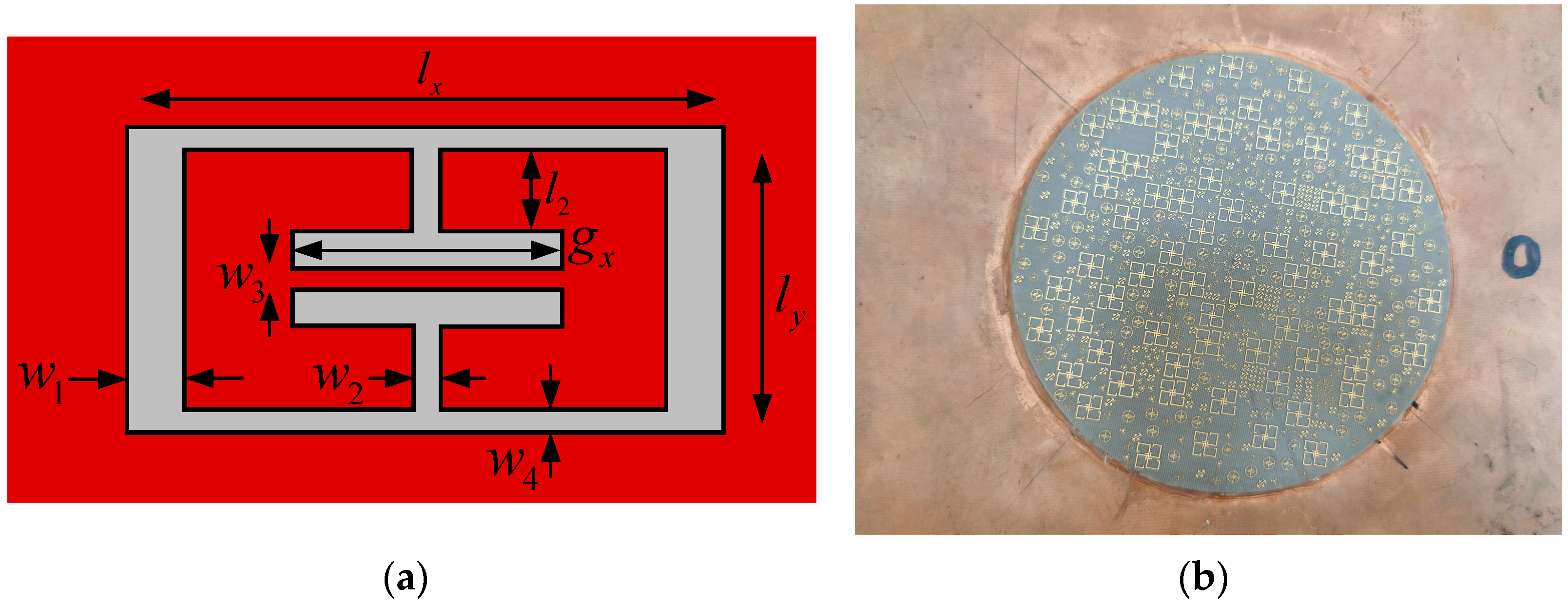
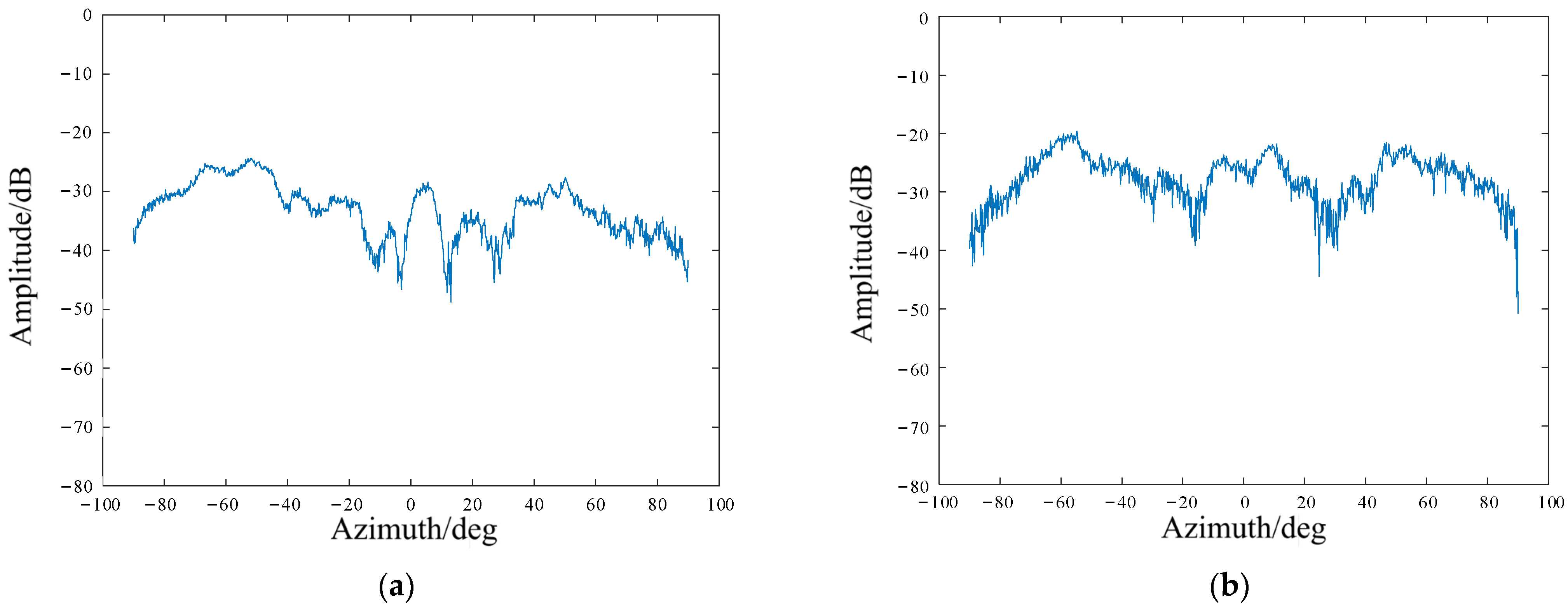
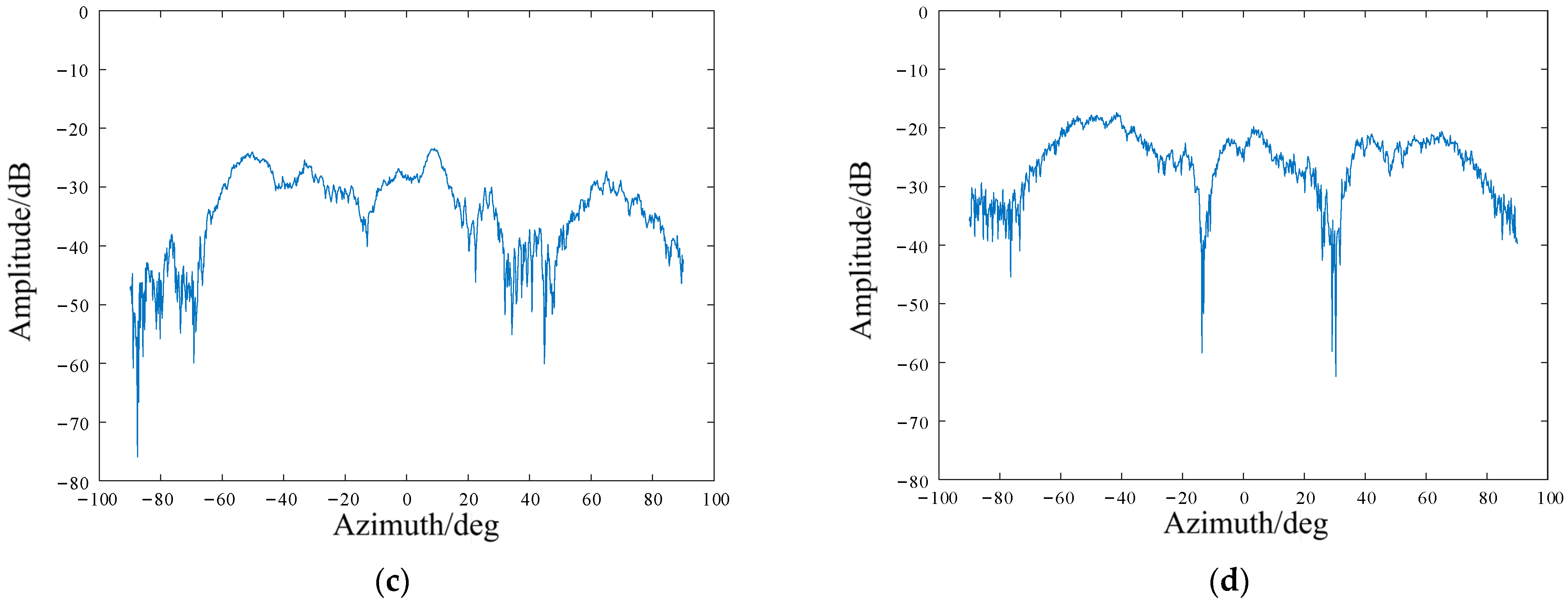
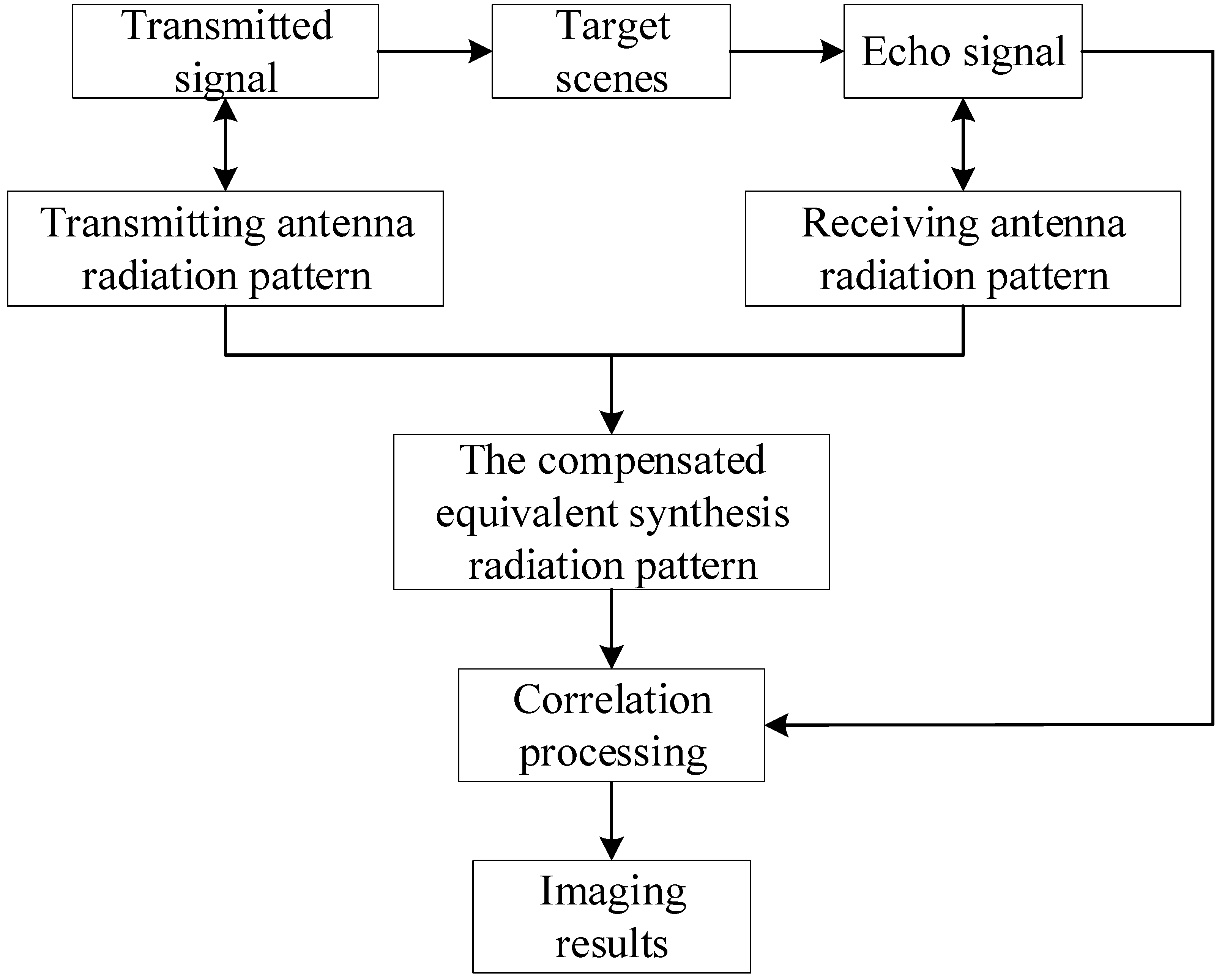
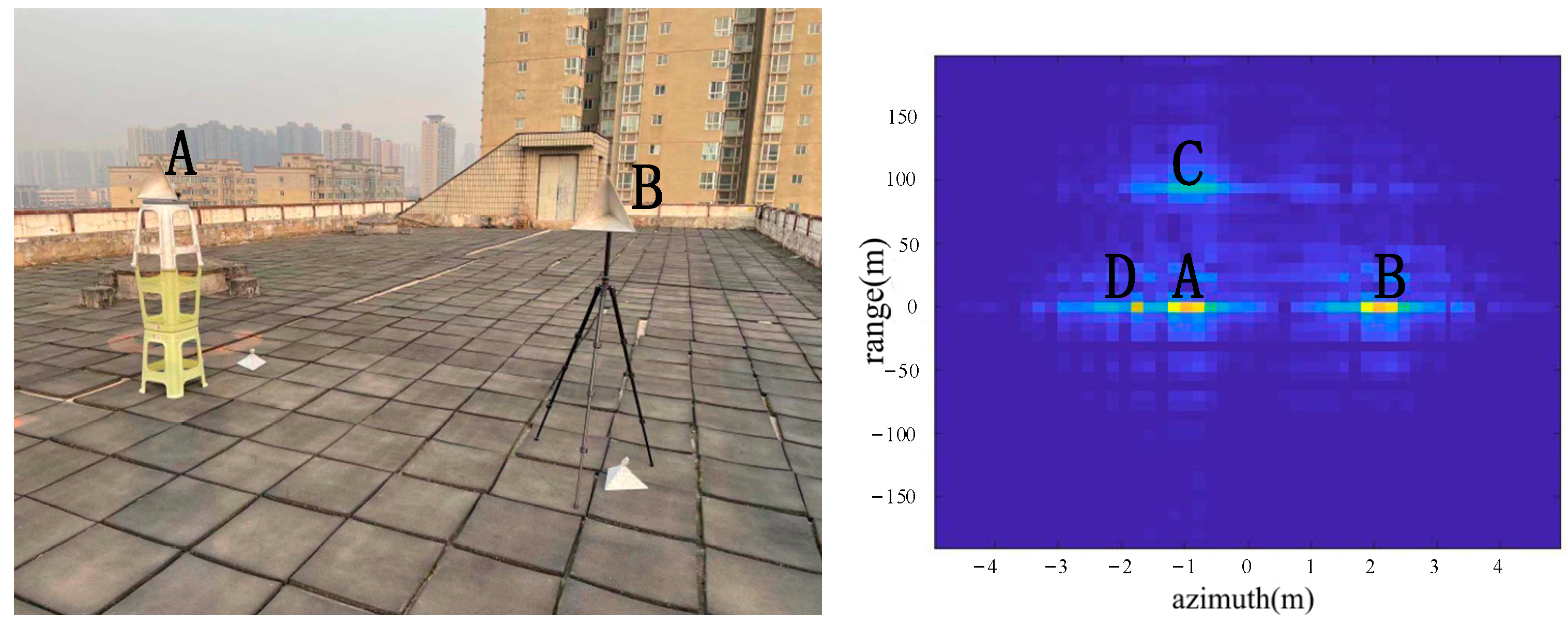
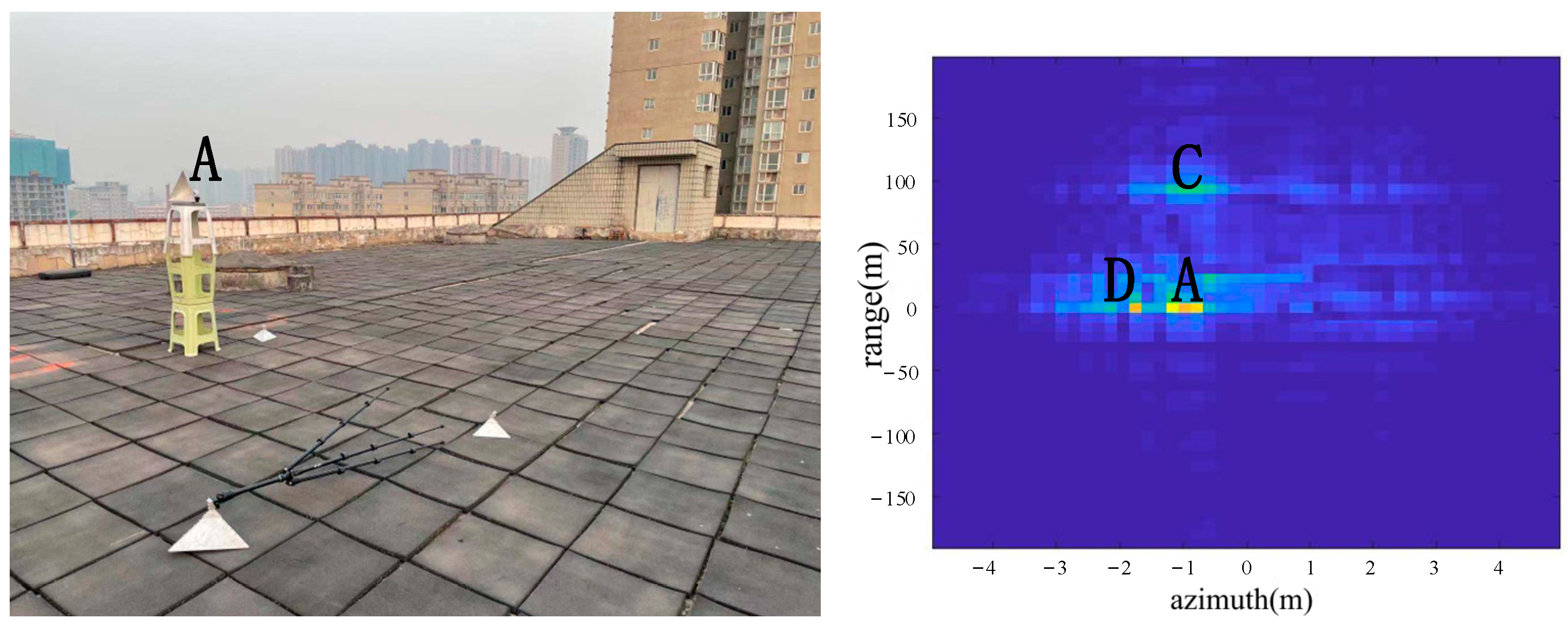
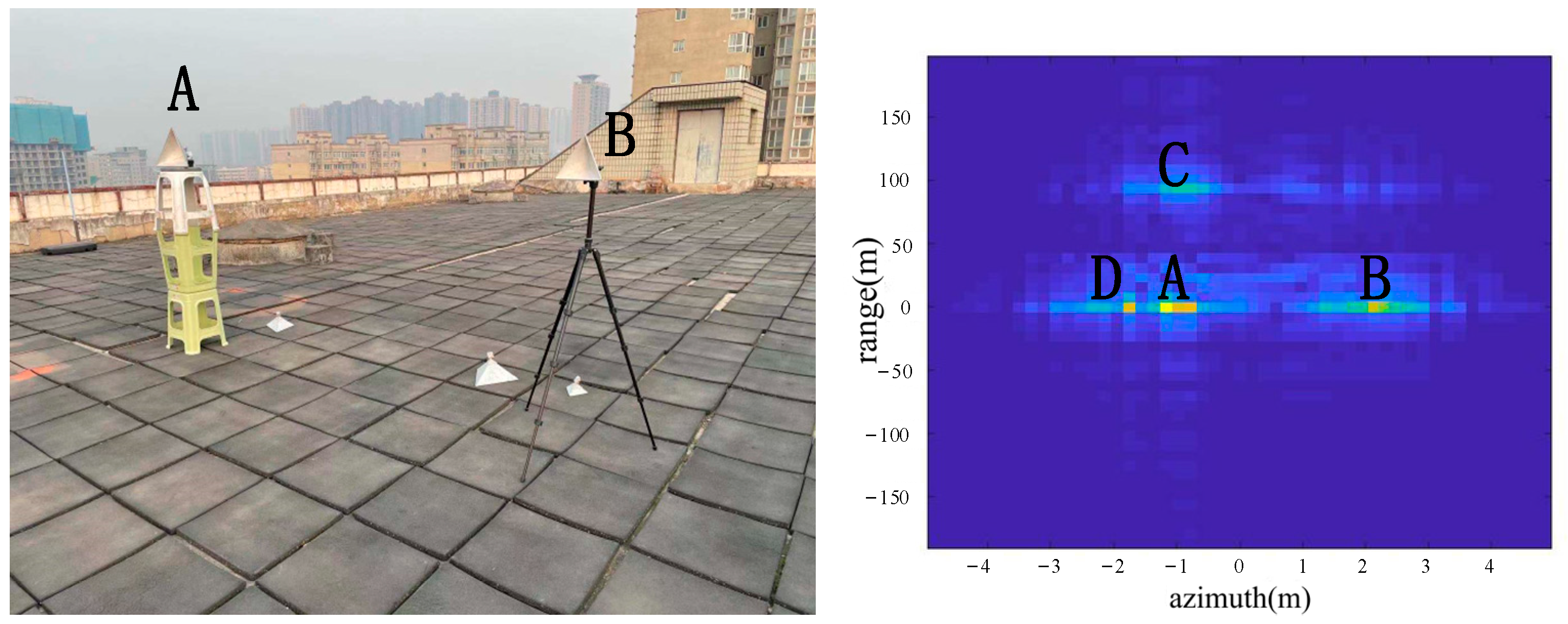


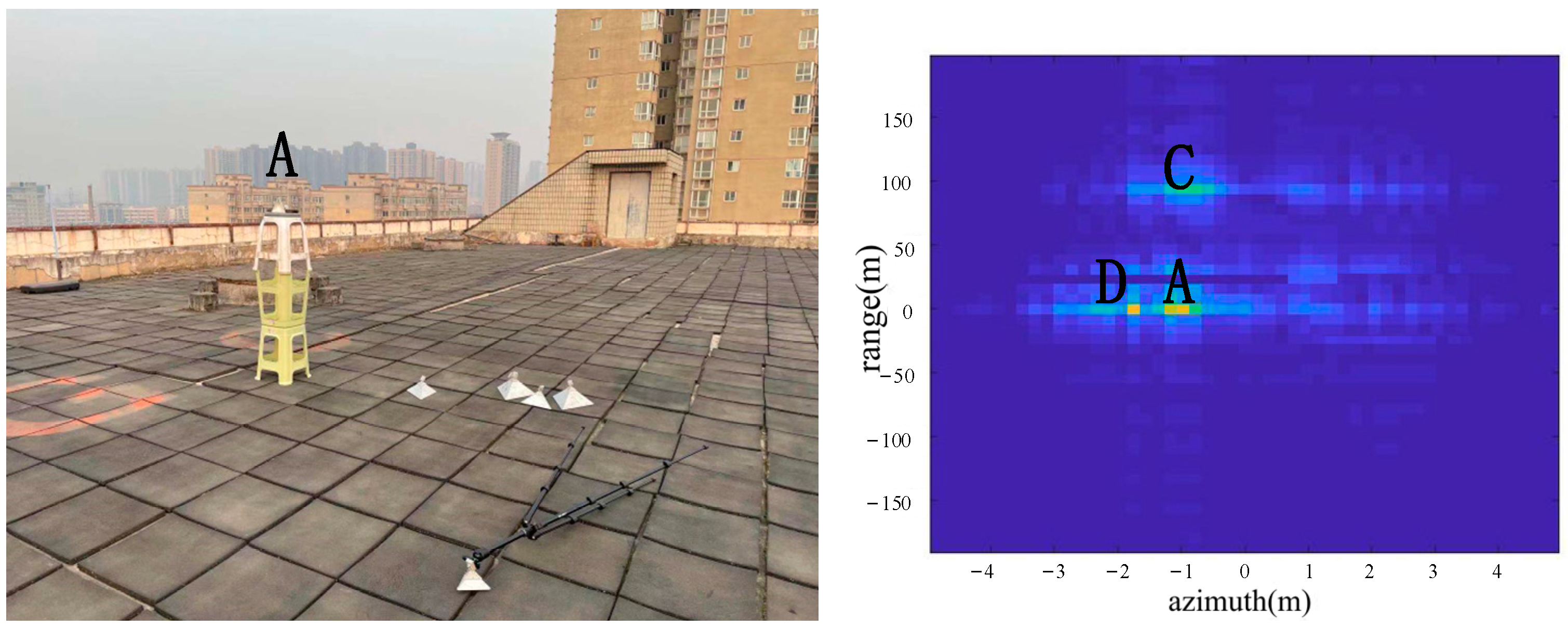
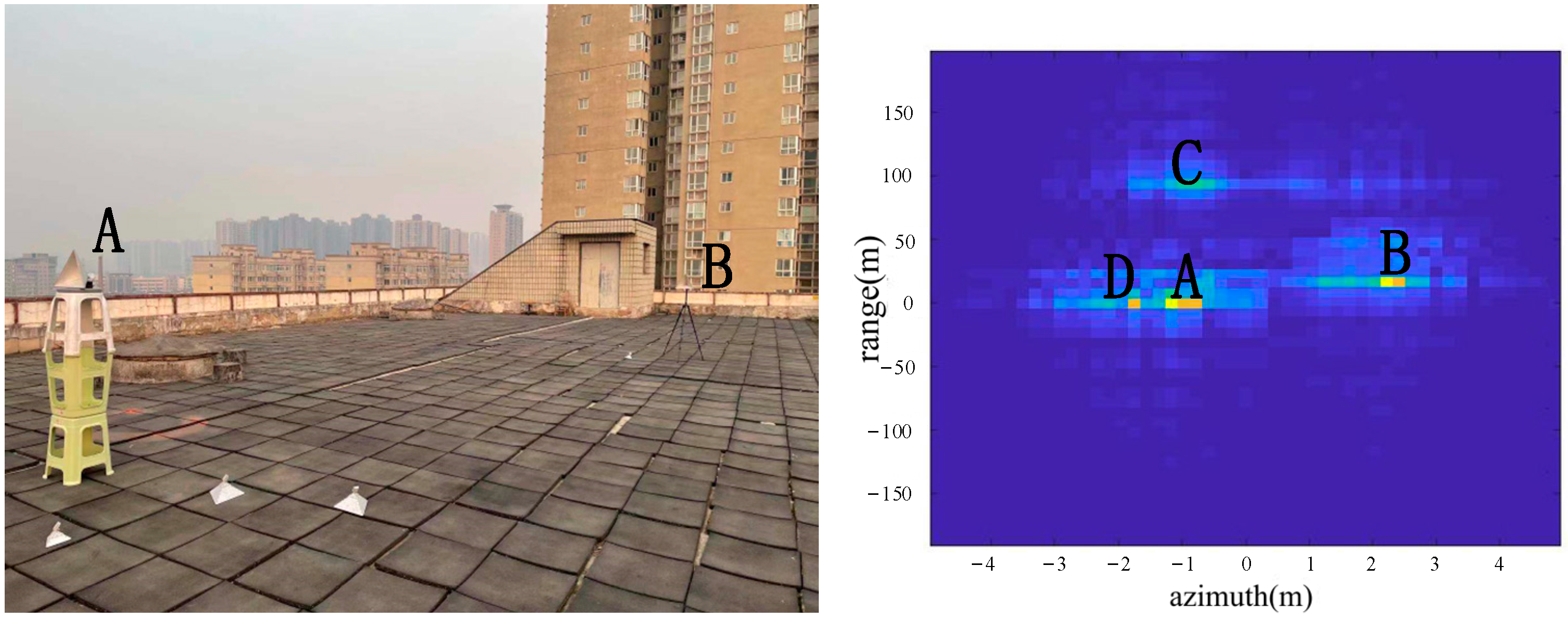

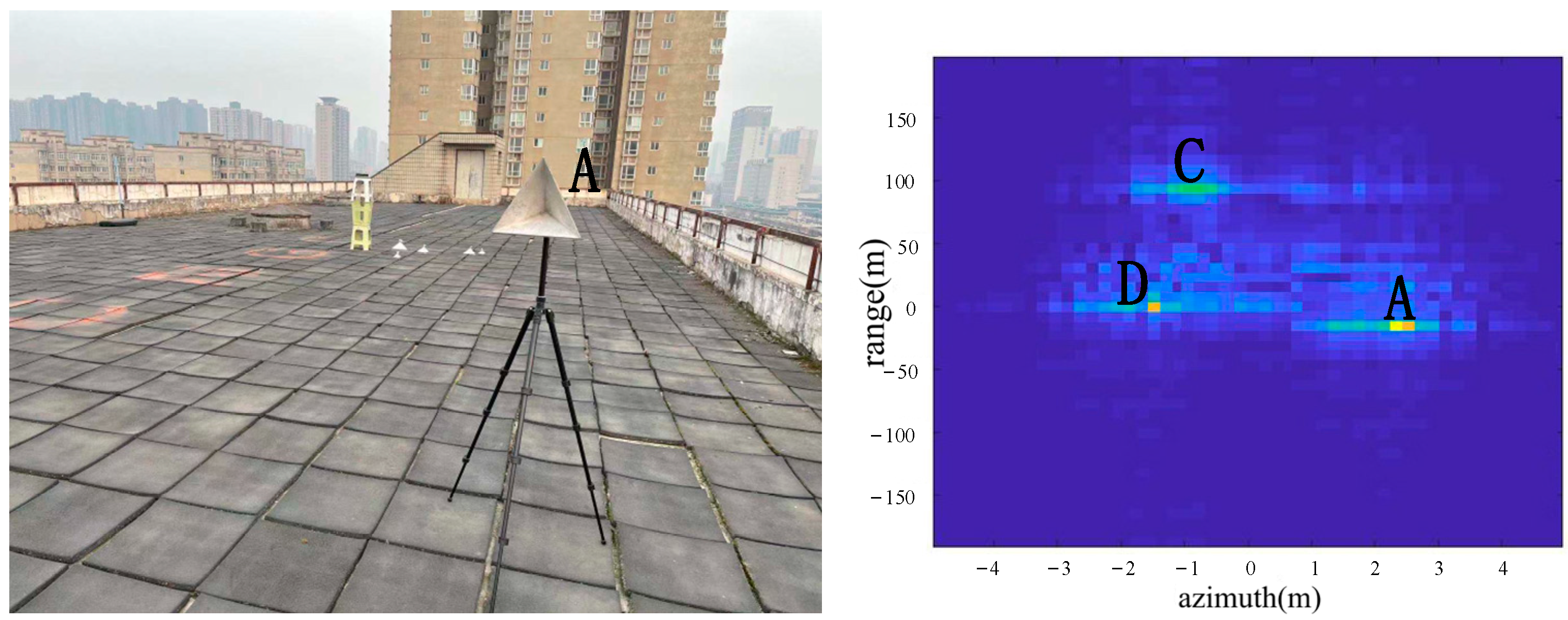

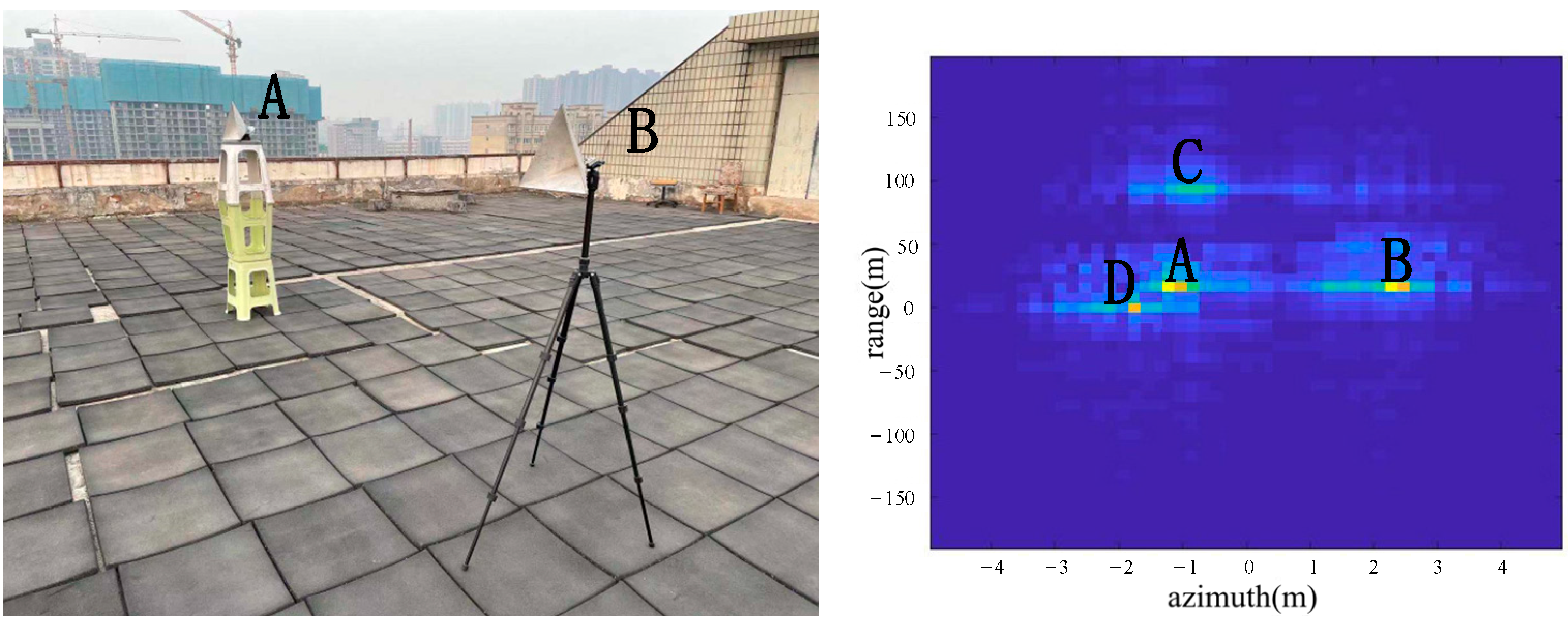
| Experimental Parameters | Values |
|---|---|
| Radar working wavelength λ | 0.0084~0.0094 m |
| 32 GHz | |
| 30 MHz | |
| Antenna beam width θ | 120 degrees |
| The distance between the center of the scene and the radar (slant distance) R | 17 m |
| Pulse sampling times Q | 128 times |
| Signal bandwidth B | 15 MHz |
| 20 MHz | |
| Carrier speed v | 0 m/s |
Publisher’s Note: MDPI stays neutral with regard to jurisdictional claims in published maps and institutional affiliations. |
© 2022 by the authors. Licensee MDPI, Basel, Switzerland. This article is an open access article distributed under the terms and conditions of the Creative Commons Attribution (CC BY) license (https://creativecommons.org/licenses/by/4.0/).
Share and Cite
Ruan, F.; Han, L.; Zhang, B.; Li, Y.; Guo, L. Low-Cost Metamaterial Antennas: Forward-Looking Imaging Experiment and Analysis. Sensors 2022, 22, 5563. https://doi.org/10.3390/s22155563
Ruan F, Han L, Zhang B, Li Y, Guo L. Low-Cost Metamaterial Antennas: Forward-Looking Imaging Experiment and Analysis. Sensors. 2022; 22(15):5563. https://doi.org/10.3390/s22155563
Chicago/Turabian StyleRuan, Feng, Liang Han, Baoheng Zhang, Yachao Li, and Liang Guo. 2022. "Low-Cost Metamaterial Antennas: Forward-Looking Imaging Experiment and Analysis" Sensors 22, no. 15: 5563. https://doi.org/10.3390/s22155563







